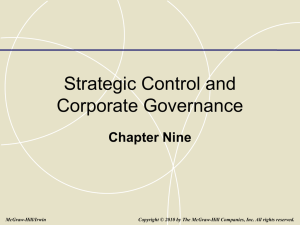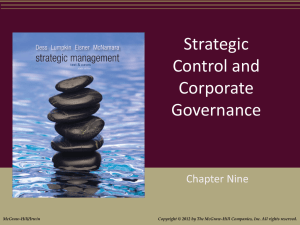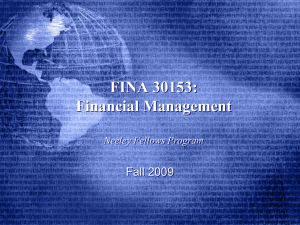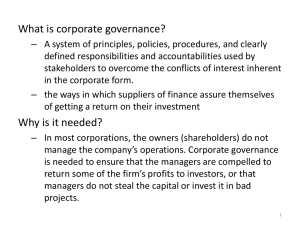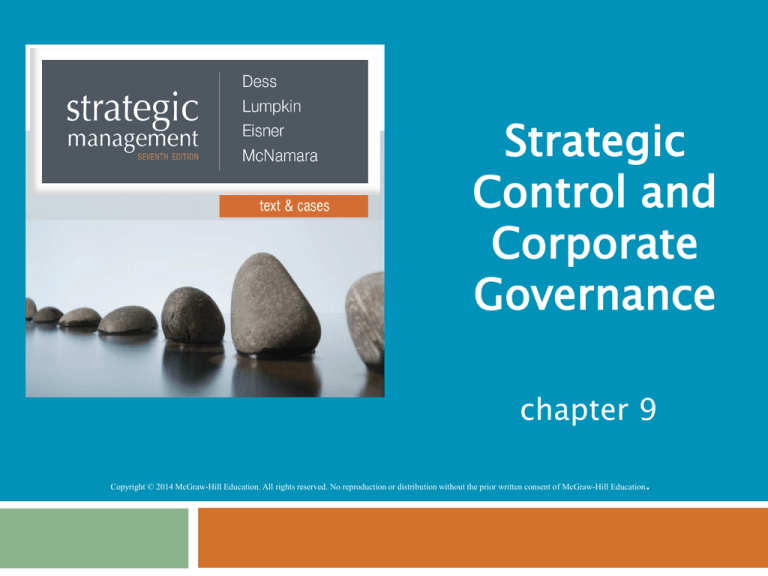
Strategic
Control and
Corporate
Governance
chapter 9
Copyright © 2014 McGraw-Hill Education. All rights reserved. No reproduction or distribution without the prior written consent of McGraw-Hill Education
.
Learning Objectives
9-2
After reading this chapter, you should have a
good understanding of:
LO9.1 The value of effective strategic control
systems in strategy implementation.
LO9.2 The key difference between “traditional” and
“contemporary” control systems.
LO9.3 The imperative for “contemporary” control
systems in today’s complex and rapidly changing
competitive and general environments.
Learning Objectives
9-3
LO9.4 The benefits of having the proper balance
among the three levers of behavioral control: culture,
rewards and incentives, and boundaries.
LO9.5 The three key participants in corporate
governance: shareholders, management (led by the
CEO), and the board of directors.
LO9.6 The role of corporate governance
mechanisms in ensuring that the interests of
managers are aligned with those of shareholders
from both the United States and international
perspectives.
Strategic Control
9-4
Consider…
Once strategy is formulated, it must be
implemented, and part of implementation is
establishing a mechanism for monitoring
and correcting organizational performance.
This control mechanism must be consistent
with the strategy the firm is following.
How does a firm make sure all key
stakeholders are moving in the right
direction?
Strategic Control
9-5
Strategic
control involves monitoring
performance toward strategic goals and
taking corrective action when needed via
effective systems:
Informational
control systems
Behavioral control systems
Corporate governance
Strategic Control:
Traditional Approach
9-6
The
traditional approach to strategic
control is sequential
Strategies
are formulated, goals are set
Strategies are implemented
Performance is measured against goals
Exhibit 9.1 Traditional Approach to Strategic Control
Strategic Control:
Traditional Approach
9-7
Control
= feedback loop from
performance measurement to strategy
formulation
Involves lengthy time lags, “single-loop”
learning
Most appropriate when
Environment
is stable and relatively simple
Objectives can be measured with certainty
Little need for complex measures of
performance
Strategic Control:
Contemporary Approach
9-8
Relationships
between strategy
formulation, implementation, & control
are highly interactive, utilizing
Informational
control
Behavioral control
Exhibit 9.2 Contemporary Approach to Strategic Control
Strategic Control:
Contemporary Approach
9-9
Informational
control = concerned with
whether or not the organization is
“doing the right things”
Behavioral control = concerned with
whether or not the organization is
“doing things right” in the
implementation of its strategy
Both types of control are necessary, but
not sufficient, conditions for success
Question?
9-10
Top managers at ABC Company meet every
Friday to review daily operational reports and
year-to-date data. This is an example of
A.
B.
C.
D.
behavioral control.
informational control.
strategy formulation.
strategy implementation.
Informational Control
9-11
Informational
control deals with both the
internal & external environment
Do the organization’s goals and
strategies still “fit” within the context of
the current strategic environment?
Two key issues:
Scan
& monitor the external environment
Continuously monitor the internal
environment
Informational Control
9-12
Informational
control = ongoing process
of organizational learning
Focus on constantly changing
information - continuous monitoring,
testing, review
Updates & challenges assumptions, so
Time
lags are shortened
Changes are detected earlier
Speed & flexibility of response is enhanced
Question?
9-13
Which of the following is not one of the
characteristics of a contemporary control
system?
A.
B.
C.
D.
It is a key catalyst for an ongoing debate about
underlying data, assumptions, and action plans.
It must focus on constantly changing information
that is strategically important.
It circumvents the need for face-to-face meetings
among superiors, subordinates, and peers.
It generates information that is important enough
to demand regular and frequent attention.
Behavioral Control
9-14
Behavioral
control = focused on
implementation – “doing things right”
Influences the actions of employees via:
Culture
Rewards
Boundaries
Exhibit 9.3 Essential Elements of Behavioral Control
Behavioral Control: Culture
9-15
Organizational
culture is a system of
Shared
values (what is important)
Beliefs (how things work)
Organizational
culture shapes a firm’s
People
Organizational
structures
Control systems
Organizational
Behavioral
culture produces
norms (the way we do things
around here)
Behavioral Control: Culture
9-16
Organizational
culture sets implicit
boundaries regarding:
Dress
Ethical
matters
The way an organization conducts its
business
A
strong culture
Leads
to greater employee engagement
Provides a common purpose and identity
Reduces monitoring costs
Behavioral Control: Culture
9-17
Effective
organizational cultures must be
Cultivated
Encouraged
Fertilized
Organizational
maintained by
cultures can be
Storytelling
Rallies
or pep talks by top executives
Behavioral Control: Rewards
9-18
Reward
systems & incentive programs:
Powerful
means of influencing an
organization’s culture
Focus efforts on high-priority tasks
Motivate individual & collective task
performance
Can be an effective motivator & control
mechanism
Behavioral Control: Rewards
9-19
Potential
downside:
Individual
actions are not related to
compensation; employees are rewarded for
the wrong things
Different business units have differing
rewards systems
Behavior reinforced within subcultures may
reflect value differences in opposition to
the dominant culture
Reward systems may lead to information
hoarding, working at cross purposes
Behavioral Control: Rewards
9-20
Exhibit 9.4 Characteristics of Effective Reward and Evaluation Systems
Behavioral Control: Boundaries
9-21
Boundaries
Focusing
and constraints can be useful
individual efforts on strategic
priorities
Providing short-term objectives and action
plans to channel efforts
Specific,
measurable, including a specific time
horizon for attainment
Achievable, yet challenging enough to motivate
Individual managers held accountable for
implementation
Question?
9-22
Rules and regulations, rather than culture or
rewards, would probably be used for strategic
control at what type of company?
A.
B.
C.
D.
Software developer
Stock brokerage firm
Manufacturer of mass-produced products
High-tech research facility
Behavioral Control: Boundaries
9-23
Boundaries
and constraints can also
Improve
efficiency and effectiveness through
rule-based controls, appropriate when
Environments
are stable and predictable
Employees are largely unskilled and
interchangeable
Consistency in product and services is critical
The risk of malfeasance is extremely high
Minimize
improper and unethical conduct via
Anti-bribery
policies
Regulations and sanctions – i.e. Sarbanes-Oxley
Behavioral Control Systems
9-24
Exhibit 9.5 Organizational Control: Alternative Approaches
Behavioral Control Systems
9-25
Rewards
and incentives, plus a strong
culture, reduce the need for external
controls, IF organizations
Hire
the right people
Train people in the dominant cultural values
Have managerial role models
Have reward systems clearly aligned with
organizational goals and objectives
Example:
Building a Strong, Rewarding Culture
9-26
Zappos hires only one out of 100 applicants - a
hiring process that is weighted 50% on job skills &
50% on the potential to mesh with Zappos’ culture.
Call center reps are measured based on how much
time they spend with customers, not how many calls
they take
Rewards include Zollars (Zappos dollars) given
by peers to peers for deserving behaviors
Because Zappos has a strong culture they can…
Run primarily using recognition with few “incentive”
programs
Eschew traditional programs – use what works for them
Corporate Governance
9-27
Corporate
governance controls focus on
relationships between
The
shareholders
The management (led by the Chief Executive
Officer - CEO)
The Board of Directors
How
can corporations succeed (or fail) in
aligning managerial motives with
The
interests of the shareholders
The interests of the board of directors
Corporate Governance
9-28
The
separation of owners (shareholders) &
management in a modern corporation
Shareholders
(investors) have limited liability
& can participate in the profits without taking
direct responsibility for operations
Management can run the company without
personally providing any funds
The Board of Directors are elected by
shareholders & have a fiduciary obligation to
protect shareholder interests
Corporate Governance:
Agency Theory
9-29
Agency
theory deals with the relationship
between principals & agents
What to do when the goals of the
principals and agents conflict?
What to do when it is difficult or
expensive for the principal to verify what
the agent is actually doing?
What happens when the principal and the
agent have different attitudes and
preferences toward risk?
Corporate Governance
Mechanisms
9-30
Corporate
governance mechanisms:
aligning the interests of owners and
managers through
A
committed and involved Board of Directors
Shareholder activism
Managerial rewards and incentives
Contract-based
outcomes
CEO duality – should the CEO also be chairman of
the board of directors?
Corporate Governance
Mechanisms
9-31
Duties
of the Board of Directors
Regularly
evaluate, and, if necessary, replace
the CEO; determine management
compensation; review succession planning.
Review & approve financial objectives, major
strategies, and plans of the Corporation.
Provide advice and counsel to top management.
Select & recommend candidates for the Board
of Directors; evaluate board processes.
Review the adequacy of all compliance systems.
Corporate Governance
Mechanisms
9-32
An
effective Board of Directors should
Become
active, critical participants
Ensure that strategic plans undergo rigorous
scrutiny
Evaluate managers against high performance
standards
Take control of the succession process
Practice director independence
No
interlocking directorships
Insist
that directors own significant stock in
the company
Corporate Governance
Mechanisms
9-33
Individual
shareholders have rights:
To
sell stock, vote the proxy, bring suit for
damages, get information, receive residual
rights following the company’s liquidation
Collectively,
shareholders have power:
To
direct the course of corporations, file
shareholder action suits, demand key issues
be brought up for proxy votes
Institutional
By
investors can be aggressive:
reviewing performance, requesting changes
in the firm’s governance structure, filing court
action, becoming major shareholders
Corporate Governance
Mechanisms
9-34
Boards
are responsible for managerial
rewards and incentives
Boards
can require that CEOs become
substantial owners of company stock
Salaries, bonuses, and stock options can be
structured so as to provide rewards for
superior performance and penalties for poor
performance
Dismissal for poor performance should be a
realistic threat
Corporate Governance
Mechanisms: CEO Duality?
9-35
Unity of Command:
(in favor of) Duality
Provides clear focus
Eliminates confusion
and conflict
Enhances a firm’s
responsiveness
Enables quick
decisions based on
first-hand knowledge
Agency Theory:
(in favor of) Separation
Safeguards against
corruption or
incompetence
Removes conflict of
interest, especially
regarding CEO
succession
Improves perceptions
of legitimacy
Corporate Governance
Mechanisms
9-36
External
The
governance control mechanisms
market for corporate control
The
takeover constraint
Auditors
Enron,
Banks
WorldCom?
and analysts
Lehman
Brothers, Countrywide?
Regulatory
bodies
Securities
and Exchange Commission (SEC)
The Sarbanes-Oxley Act
Media
and public activists
Bloomberg
Businessweek, Ralph Nader
Example:
Corporate Governance & Stakeholder Groups
9-37
AIG (American International Group) paid $218
million in bonuses to its financial services division
employees AFTER receiving an $85 billion bailout
from the U.S. government
The U.S. House of representatives complained
AIG leadership caved in
AIG financial services managers were
left without an income
Many AIG financial services managers were AIG
shareholders
Was corporate governance effective? Were external
governance control mechanisms inappropriate?
International Corporate
Governance
9-38
Principal
– principal conflicts (vs principal –
agent conflicts) involve
Concentrated
ownership, or family ownership
Motivation
to engage in expropriation of minority
shareholders for personal gain
Business
action
groups who can take coordinated
Japanese
Few
keiretsus, Korean chaebols
external regulatory constraints
International Corporate
Governance
9-39
Exhibit 9.9 Principal-Agent Conflicts and Principal-Principal Conflicts:
A Diagram
Source: Young, M.N., Peng, M.W., Ahlstrom, D., Bruton, G.D., & Jiang, 2008. Principal-Principal Conflicts in
Corporate Governance. Journal of Management Studies 45(1):196-220; and Peng, M.V. 2006. Global Strategy.
Cincinnati: Thomson South-Western. We are very appreciative of the helpful comments of Mike Young of Hong
Kong Baptist University and Mike Peng of the University of Texas at Dallas.


